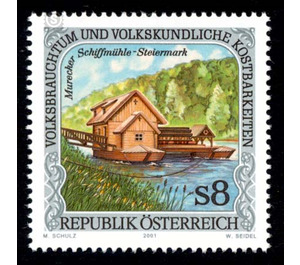folklore - Austria / II. Republic of Austria 2001 - 8 Shilling
Theme: Art & Culture
| Country | Austria / II. Republic of Austria |
| Issue Date | 2001 |
| Face Value | 8.00 |
| Edition Issued | 2,000,000 |
| Printing Type | combination printing |
| Stamp Type | Commemorative |
| Item Type | Stamp |
| Chronological Issue Number | 1681 |
| Chronological Chapter | OOS-OE2 |
| SID | 370463 |
| In 59 Wishlists | |
1200 years ago in Mesopotamia there were already water wheels for irrigation purposes. One thousand years later, running water was used to power such wheels. Soon one came up with the idea to use the power of the water also for driving a mill. 25 BC A Roman engineer already describes a watermill that resembles a farmer's mill. When about 500 years later, the Ostrogoths put the water supply of Rome and thus the watermills out of service, the Romans helped with ship mills on the Tiber. On the Danube, Rhine, Drau u.a. There were many ship mills in rivers later on. 150 years ago in the area of Radkersburg there were 43 on the Mur. The increasing concentration on large mills finally let the little ones fall. In many places, such as in Mureck, traditional associations were established, which restore old mills or, according to old models, build new ones, as in Mureck. There they grind today wheat, spelled wheat and rye with shell and seedling from organic farming and sold directly from the mill. When you are exhausted, you will be spoiled with Styrian specialties in the Mühlenhof, where the special post office will be located. The nature radiating brand comes from Maria Schulz, the engraving by Prof. Wolfgang Seidel.


